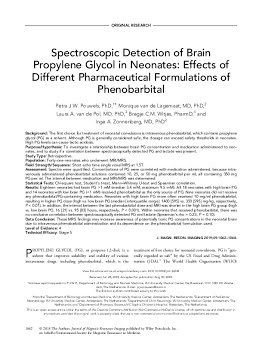2019
Spectroscopic detection of brain propylene glycol in neonates: Effects of different pharmaceutical formulations of phenobarbital
Publication
Publication
Journal of Magnetic Resonance Imaging , Volume 49 - Issue 4 p. 1062- 1068
Background The first choice for treatment of neonatal convulsions is intravenous phenobarbital, which contains propylene glycol (PG) as a solvent. Although PG is generally considered safe, the dosage can exceed safety thresholds in neonates. High PG levels can cause lactic acidosis.
Purpose/Hypothesis To investigate a relationship between brain PG concentration and medication administered to neonates, and to study if a correlation between spectroscopically detected PG and lactate was present.
Study Type Retrospective.
Population Forty‐one neonates who underwent MRI/MRS.
Field Strength/Sequence Short echo time single voxel MRS at 1.5T.
Assessment Spectra were quantified. Concentrations of PG were correlated with medication administered, because intravenously administered phenobarbital solutions contained 10, 25, or 50 mg phenobarbital per ml, all containing 350 mg PG per ml. The interval between medication and MRI/MRS was determined.
Statistical Tests Chi‐square test, Student's t‐test, Mann–Whitney U‐test and Spearman correlation.
Results Eighteen neonates had brain PG >1 mM (median 3.4 mM, maximum 9.5 mM). All 18 neonates with high brain PG and 14 neonates with low brain PG (<1 mM) received phenobarbital as the only source of PG. Nine neonates did not receive any phenobarbital/PG‐containing medication. Neonates with high brain PG more often received 10 mg/ml phenobarbital, resulting in higher PG dose (high vs. low brain PG (median [interquartile range]: 1400 [595] vs. 350 [595] mg/kg, respectively, P < 0.01). In addition, the interval between the last phenobarbital dose and MRI was shorter in the high brain PG group (high vs. low brain PG: 16 [21] vs. 95 [83] hours, respectively, P < 0.001). Within neonates that received phenobarbital, there was no conclusive correlation between spectroscopically detected PG and lactate (Spearman's rho = 0.23, P = 0.10).
Data Conclusion These MRS findings may increase awareness of potentially toxic PG concentrations in the neonatal brain due to intravenous phenobarbital administration and its dependence on the phenobarbital formulation used.
Level of Evidence:4Technical Efficacy:Stage 5
| Additional Metadata | |
|---|---|
| doi.org/10.1002/jmri.26344, hdl.handle.net/1765/116361 | |
| Journal of Magnetic Resonance Imaging | |
| Organisation | Department of Pharmacy |
|
Pouwels, P., van de Lagemaat, M., van de Pol, L.A., Witjes, B.C.M., & Zonnenberg, I. (2019). Spectroscopic detection of brain propylene glycol in neonates: Effects of different pharmaceutical formulations of phenobarbital. Journal of Magnetic Resonance Imaging, 49(4), 1062–1068. doi:10.1002/jmri.26344 |
|

